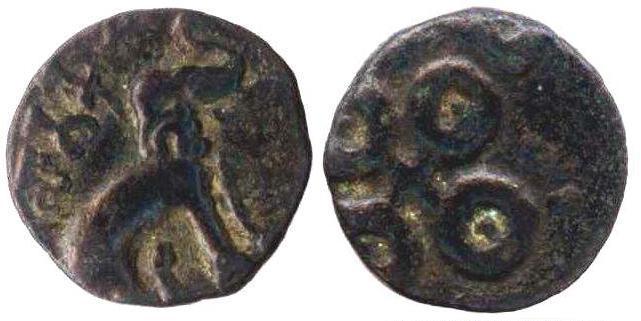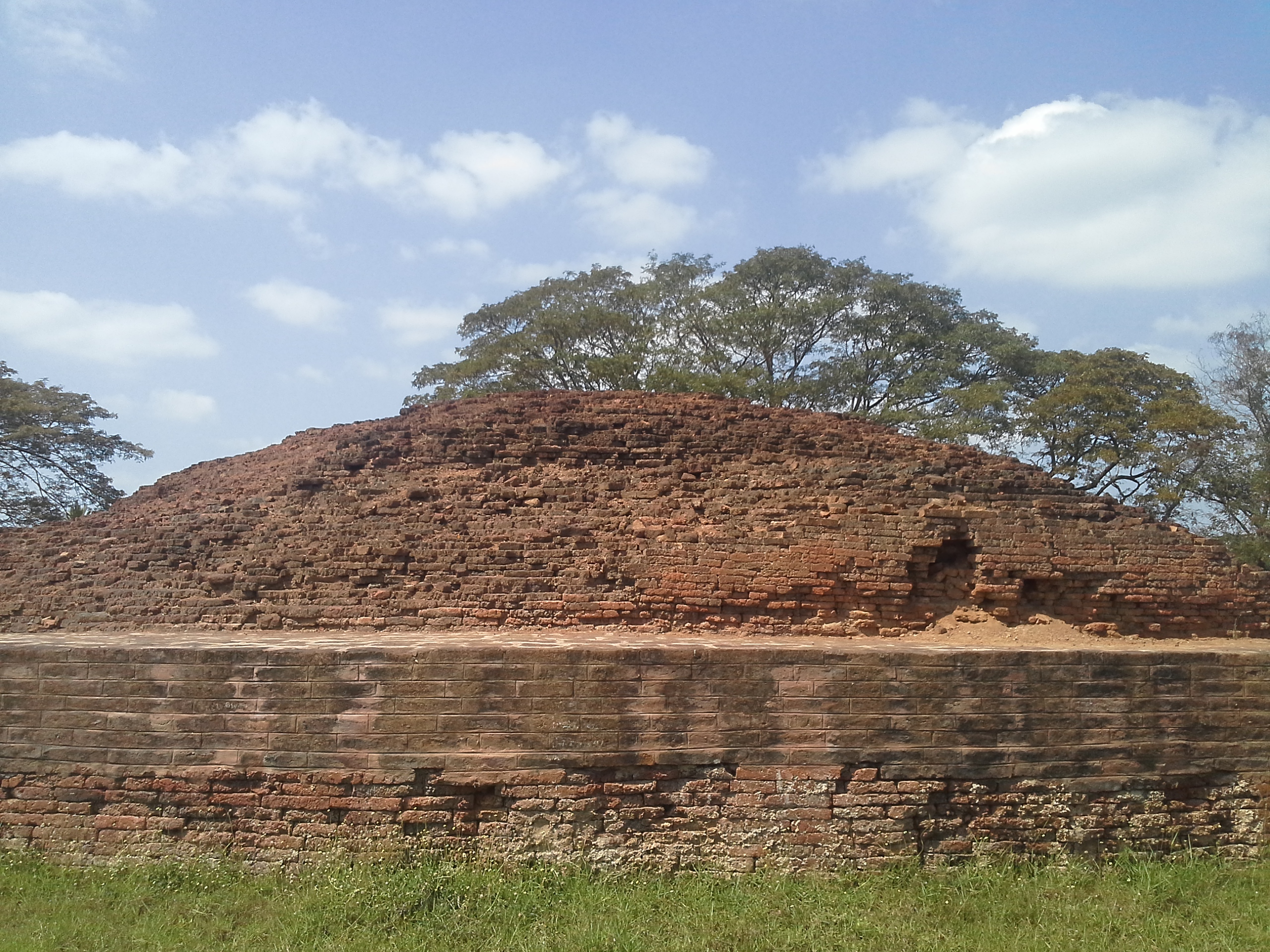|
Mahameghavahana
The Mahameghavahana dynasty ( (Brahmi:𑀫𑀳𑀫𑁂𑀖𑀯𑀸𑀳𑀦) 2nd or 1st century BC to early 4th century CE) was an ancient ruling dynasty of Kalinga (historical kingdom), Kalinga after the decline of the Maurya Empire.For a map of their territory see: In the first century B.C., Mahameghavahana, a king of Chedirastra (or Cetarattha, i.e., kingdom of the Chedi Kingdom, Chedis) conquered Kalinga (historical region), Kalinga and Kosala. During the reign of Kharavela, the third king of Mahameghavahana dynasty, South Kosala became an integral part of the kingdom. He patronised Jainism, but did not discriminate against other religions. He is known by his Hathigumpha inscription. South Kosala was later conquered by Gautamiputra Satakarni of the Satavahana dynasty in the early part of the 2nd century CE and remained in their possession up to the second half of the 2nd century CE. It was during the second and third century CE, the Meghas or Meghavahanas reappeared in the ... [...More Info...] [...Related Items...] OR: [Wikipedia] [Google] [Baidu] |
Kharavela
Kharavela was the emperor of Kalinga (present-day eastern coast of India) in the 2nd or 1st century BC. The primary source for Kharavela is his rock-cut Hathigumpha inscription. The inscription is undated, only four of its 17 lines are completely legible, others unclear, variously interpreted and disputed by scholars. The inscription written with Jainism-related phrases recites a year by year record of his reign and panegyrically credits him with public infrastructure projects, welfare activities, patronage of the arts, and many military victories. Historians agree that it is best and most complete biography of Kharavela available. He was a follower of Jainism. Background Sources Much of the available information about Kharavela comes from the undated, much damaged Hathigumpha inscription and several minor inscriptions found in the Udayagiri and Khandagiri Caves in present-day Odisha. The Hathigumpha inscription records Kharavela's life until his 38th year, including 13 ... [...More Info...] [...Related Items...] OR: [Wikipedia] [Google] [Baidu] |
Kalinga (historical Kingdom)
Kalinga is a historical region of India. It is generally defined as the eastern coastal region between the Ganges and the Godavari rivers, although its boundaries have fluctuated with the territory of its rulers. The core territory of Kalinga now encompasses all of Odisha and some part of northern Andhra Pradesh. At its widest extent, the Kalinga region also included parts of present-day Chhattisgarh, extending up to Amarkantak in the west. In the ancient period it extended until the bank of the Ganges river. The Kalingas have been mentioned as a major tribe in the legendary text '' Mahabharata''. In the 3rd century BCE, the region came under Mauryan control as a result of the Kalinga War. It was subsequently ruled by several regional dynasties whose rulers bore the title ''Kalingādhipati'' ("Lord of Kalinga"); these dynasties included Mahameghavahana, Vasishtha, Mathara, Pitrbhakta, Shailodbhava, Bhaumkara, Somavamshi, and Eastern Ganga. The medieval era ruler ... [...More Info...] [...Related Items...] OR: [Wikipedia] [Google] [Baidu] |
Mahendra Of Dakshina Kosala
Mahendra was a king of Dakshina Kosala, whose identity is not completely verified, and is mentioned as a king of Dakshinapatha or Southern India. He was one of the many kings who were subjugated, captured and later released by the powerful Gupta emperor Samudragupta on his Dakshinapatha (Southern India) campaign. Mahendra of Kosala was one of the southern kings of Dakshinapatha paying allegiance and tribute to Samudragupta. His dynasty is uncertain, though some historians suggest that he was from the Kosala branch of the Mahameghavahana dynasty. This branch of the Mahameghavahana dynasty is often identified with the Meghas of Kosala, who ruled over Kosala from the 3rd century AD to the 6th century AD. Other theories suggest that he was a king of a branch the Ikshvaku dynasty, who had established a mighty kingdom in the south. Yet another theory identifies Mahendra with a Nala Nala () is a legendary king of ancient Nishadha kingdom and the central protagonist of the '' Nalopak ... [...More Info...] [...Related Items...] OR: [Wikipedia] [Google] [Baidu] |
Hathigumpha Inscription
The Hathigumpha Inscription (pronounced: ɦɑːt̪ʰiːgumpʰɑː) is a seventeen line inscription in a Prakrit language incised in Brahmi script in a cavern called Hathigumpha in Udayagiri hills, near Bhubaneswar in Odisha, India. Dated between the second century BCE and the first century CE, it was inscribed by the Jain king Kharavela of the Kalinga kingdom. The Hathigumpha Inscription presents, among other topics, a biographical sketch of a king in the eastern region of ancient India (now part of and near Odisha). It also includes information on religious values, public infrastructure projects, military expeditions and their purposes, society and culture. Paleographically, the inscription dates from the middle of the first century BCE to the early first century CE. Location and history The Hathigumpha inscription () of Kharavela is found at Udayagiri, about west of Bhubaneswar international airport. The Udayagiri hills host many ancient rock-cut caves such as the Rani ... [...More Info...] [...Related Items...] OR: [Wikipedia] [Google] [Baidu] |
Jainism
Jainism ( ), also known as Jain Dharma, is an Indian religions, Indian religion whose three main pillars are nonviolence (), asceticism (), and a rejection of all simplistic and one-sided views of truth and reality (). Jainism traces its spiritual ideas and history through the succession of twenty-four , supreme preachers of ''dharma''. The first in the current time cycle is Rishabhadeva, who tradition holds lived millions of years ago; the 23rd is Parshvanatha, traditionally dated to the 9th century Common Era, BCE; and the 24th is Mahāvīra, Mahavira, who lived . Jainism is considered an eternal ''dharma'' with the guiding every time cycle of the Jain cosmology, cosmology. Central to understanding Jain philosophy is the concept of ''bhedavijñāna'', or the clear distinction in the nature of the soul and non-soul entities. This principle underscores the innate purity and potential for liberation within every Jīva (Jainism), soul, distinct from the physical and menta ... [...More Info...] [...Related Items...] OR: [Wikipedia] [Google] [Baidu] |
Chedi Kingdom
Chedi () was a realm, kingdom which fell roughly in the Bundelkhand division of Madhya Pradesh regions to the south of river Yamuna along the river Ken River, Ken. Its capital city was called Suktimati in Sanskrit. According to the Mahabharata, the Chedi kingdom was ruled by Shishupala, an ally of Jarasandha of Magadha kingdom, Magadha and Duryodhana of Kuru kingdom, Kuru. He was a rival of Krishna in the Mahābhārata, Vasudeva Krishna who was his uncle's son. He was killed by Krishna in the Mahābhārata, Vasudeva Krishna during the Rajasuya sacrifice of the Pandava king Yudhishthira. Nakula's wife was from Chedi. Prominent Chedis during the Kurukshetra War included Damaghosha, Shishupala, Dhrishtaketu, Suketu, Sarabha, Nakula's wife Karenumati, Dhrishtaketu's sons. Other Chedis included King Uparichara Vasu, his children, King Suvahu, King Sahaja. It was ruled during early periods by ''Paurava'' kings and later by Yadava kings in the central part of the country. Puranas ... [...More Info...] [...Related Items...] OR: [Wikipedia] [Google] [Baidu] |
Maurya Empire
The Maurya Empire was a geographically extensive Iron Age historical power in South Asia with its power base in Magadha. Founded by Chandragupta Maurya around c. 320 BCE, it existed in loose-knit fashion until 185 BCE. The primary sources for the written records of the Mauryan times are partial records of the lost history of Megasthenes in Roman texts of several centuries later; the Edicts of Ashoka, which were first read in the modern era by James Prinsep after he had deciphered the Brahmi script, Brahmi and Kharoshthi script, Kharoshthi scripts in 1838; and the ''Arthashastra'', a work first discovered in the early 20th century,: "... another source that enjoyed high standing as a description of the early Mauryan state was the Arthashastra, a treatise on power discovered in the early twentieth century." and previously attributed to Chanakya, but now thought to be composed by multiple authors in the first centuries of the common era. Archaeologically, the period of Maury ... [...More Info...] [...Related Items...] OR: [Wikipedia] [Google] [Baidu] |
Satavahana Dynasty
The Satavahanas (; ''Sādavāhana'' or ''Sātavāhana'', IAST: ), also referred to as the Andhras (also ''Andhra-bhṛtyas'' or ''Andhra-jatiyas'') in the Puranas, were an ancient Indian dynasty. Most modern scholars believe that the Satavahana rule began in the late 2nd century BCE and lasted until the early 3rd century CE, although some assign the beginning of their rule to as early as the 3rd century BCE based on the Puranas, but uncorroborated by archaeological evidence. The Satavahana kingdom mainly comprised the present-day Andhra Pradesh, Telangana, and Maharashtra. At different times, their rule extended to parts of modern Gujarat, Madhya Pradesh, and Karnataka. The dynasty had different capital cities at different times, including Pratishthana (Paithan) and Amaravati ( Dharanikota). The origin of the dynasty is uncertain, but according to the Puranas, their first king overthrew the Kanva dynasty. In the post-Maurya era, the Satavahanas established peace in the Decca ... [...More Info...] [...Related Items...] OR: [Wikipedia] [Google] [Baidu] |
Andhra Pradesh
Andhra Pradesh (ISO 15919, ISO: , , AP) is a States and union territories of India, state on the East Coast of India, east coast of southern India. It is the List of states and union territories of India by area, seventh-largest state and the List of states and union territories of India by population, tenth-most populous in the country. Telugu language, Telugu is the most widely spoken language in the state, as well as its official language. Amaravati is the state capital, while the largest city is Visakhapatnam. Andhra Pradesh shares borders with Odisha to the northeast, Chhattisgarh to the north, Karnataka to the southwest, Tamil Nadu to the south, Telangana to northwest and the Bay of Bengal to the east. It has the Coastline of Andhra Pradesh, third-longest coastline in India at about . Archaeological evidence indicates that Andhra Pradesh has been continuously inhabited for over 247,000 years, from early archaic Hominini, hominins to Neolithic settlements. The earliest r ... [...More Info...] [...Related Items...] OR: [Wikipedia] [Google] [Baidu] |
Ganges
The Ganges ( ; in India: Ganga, ; in Bangladesh: Padma, ). "The Ganges Basin, known in India as the Ganga and in Bangladesh as the Padma, is an international which goes through India, Bangladesh, Nepal and China." is a trans-boundary river of Asia which flows through India and Bangladesh. The river rises in the western Himalayas in the States and union territories of India, Indian state of Uttarakhand. It flows south and east through the Gangetic Plain, Gangetic plain of North India, receiving the right-bank tributary, the Yamuna, which also rises in the western Indian Himalayas, and several left-bank tributaries from Nepal that account for the bulk of its flow. In West Bengal state, India, a feeder canal taking off from its right bank diverts 50% of its flow southwards, artificially connecting it to the Hooghly River. The Ganges continues into Bangladesh, its name changing to the Padma River, Padma. It is then joined by the Jamuna River (Bangladesh), Jamuna, the lower str ... [...More Info...] [...Related Items...] OR: [Wikipedia] [Google] [Baidu] |
Kaveri
The Kaveri (also known as Cauvery) is a Rivers of India, major river flowing across Southern India. It is the third largest river in the region after Godavari River, Godavari and Krishna River, Krishna. The catchment area of the Kaveri basin is estimated to be and encompasses the states of Tamil Nadu, Karnataka, Kerala, and the union territory of Puducherry (union territory), Puducherry. The river rises at Talakaveri in the Brahmagiri (hill), Karnataka, Brahmagiri range in the Western Ghats. The source is located at an elevation of in the Kodagu district of Karnataka. The river flows for about through the Deccan plateau in Karnataka before entering Tamil Nadu. It flows further eastward in Tamil Nadu for before flowing into the Bay of Bengal near Puhar, Mayiladuthurai, Poompuhar in Mayiladuthurai district of Tamil Nadu. The river flows for a total length of about . The major tributaries include Amaravati River, Amaravati, Arkavati, Bhavani River, Bhavani, Hemavati River, He ... [...More Info...] [...Related Items...] OR: [Wikipedia] [Google] [Baidu] |








